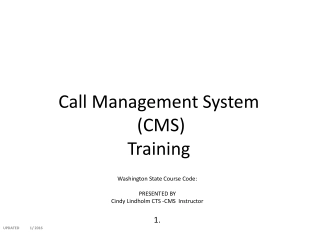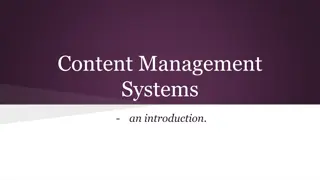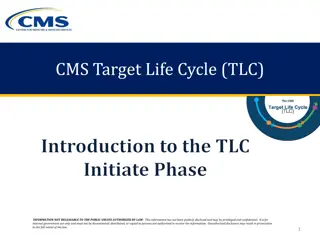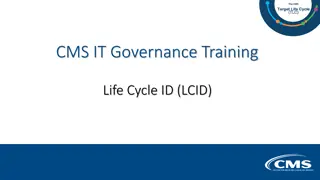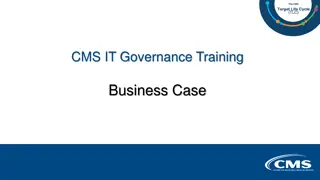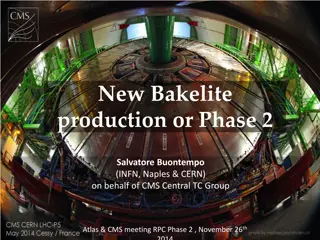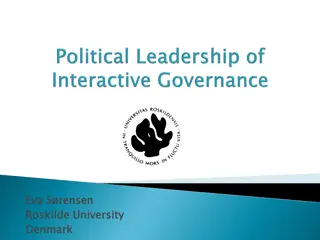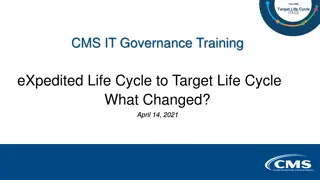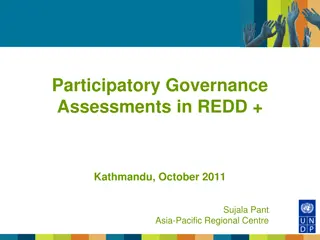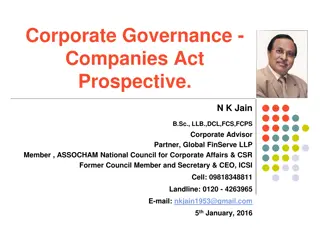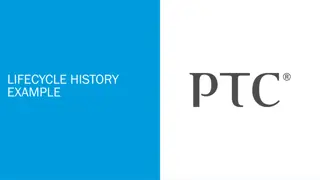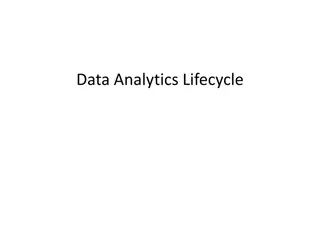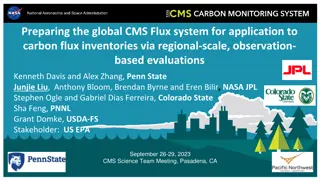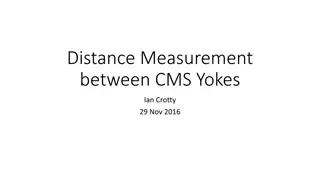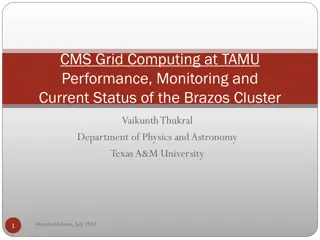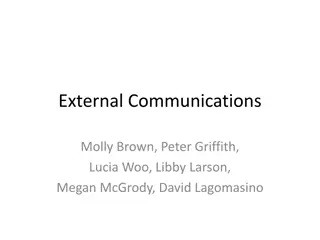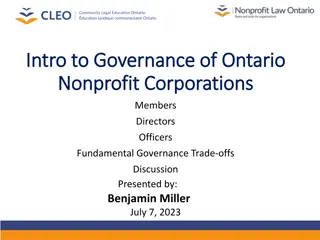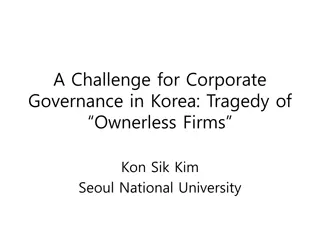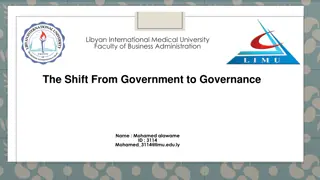CMS IT Governance Process: Intro to the Target Lifecycle
The target lifecycle governance process, including an overview of the TLC phases, the TLC framework, IT planning governance, team responsibilities, and audit requirements.
- Target lifecycle
- governance process
- TLC phases
- TLC framework
- IT planning governance
- team responsibilities
- audit requirements
Download Presentation

Please find below an Image/Link to download the presentation.
The content on the website is provided AS IS for your information and personal use only. It may not be sold, licensed, or shared on other websites without obtaining consent from the author. Download presentation by click this link. If you encounter any issues during the download, it is possible that the publisher has removed the file from their server.
E N D
Presentation Transcript
CMS IT Governance Process: Intro to the Target Lifecycle INFORMATION NOT RELEASABLE TO THE PUBLIC UNLESS AUTHORIZED BY LAW: This information has not been publicly disclosed and may be privileged and confidential. It is for internal government use only and must not be disseminated, distributed, or copied to persons not authorized to receive the information. Unauthorized disclosure may result in prosecution to the full extent of the law. 1
Target Life Cycle Governance Process What this course covers: Section I: What is the TLC? Section II: Who is the TLC? Section III: A brief overview of the Four TLC phases 2
TLC Overview Section I Section I What is the TLC? 3
Governance Framework A framework that: Promotes business flexibility Applies situational governance reviews instead of gate reviews Provides minimal disruption to the system development process Requires self governance by Project Teams Project Team Responsibility 4
Target Life Cycle (TLC) Planning Your Project We ve moved most of the external oversight up front You must develop your ideas and direction prior to Acquisition Planning We ve developed a team of IT SMEs to act as your consultants for IT planning Ensures due diligence and sound IT Planning Governance through Enablement 5
Team Responsibility Methodology Based There are an almost overwhelming number of governance laws and guidelines with which project teams must comply. Some areas in CMS have dedicated groups to ensure compliance with their particular scope, such as: Security Accessibility For other areas, project teams should follow processes in their specific methodology to fulfill the IT governance requirements 6
Potential for Audit Many paths to success Artifacts and documentation to support the design and development of the system must be available for Audit purposes, preferably on CMS infrastructure, so Project Teams must maintain and track it Interfacing with other systems, either within or outside of CMS, will require documentation acceptable to both parties Developing a comprehensive set of templates for CMS previous governance framework are perfectly acceptable to use for the TLC Those optional templates are available on the TLC website, CMS.gov/TLC 7
Proactive Governance Proactive governance is the key! We cannot do this without business and system owner cooperation Eliminating formal periodic reviews does not remove the need for the supporting work needed Every Systems Development Life Cycle (SDLC) has its own process of planning and documenting systems development Project Managers are now responsible for adherence to the standards of their chosen Project Management Methodology and SDLC that support governance goals 8
TLC Overview Section II Section II Who is the TLC? 9
GRT Purpose & Goals The Governance Review Team Governance Review Team Advises Project Teams: How to proceed through the IT Governance process What resources are available to help How to properly develop and document their Business Case and Alternatives Analysis How to adhere to required governance oversight The Project Team is responsible for documenting the proposed solutions in their Business Case, for presentation to the Governance Review Board (GRB) 10
Governance Review Team (GRT) Enterprise Architecture Records Management Technical Review Board Governance Review Team Security & Privacy Financial Management GRT Governance Review Team Shared Services Acquisitions Investment Management Accessibility Infrastructure Component representatives who have expertise in particular technical solutions may join the GRT as needed 11
GRT Purpose & Goals (contd.) The GRT: Governance Review Team Reviews the business case and alternatives analysis to ensure the application/ functionality is: Not duplicative of another effort Fills a need that's not addressed Aligns with the CMS IT Portfolio goals Discusses alternative approaches for implementation (if any) of the desired system functionality or new application Makes recommendations to the Governance Review Board (GRB) 12
Governance Review Board (GRB) The Project Team will present the Business Case and Alternatives Analysis to the Governance Review Board (GRB) Governance Review Team This should be a high level presentation of the Business Case and Alternatives, presented by the Business Owner or Manager The GRB may ask technical questions, so there should be technical staff available at the presentation as well The GRB does not approve funding for a project, but is a prerequisite for requesting funding. 13
GRB Membership Co-Chairs, Office Director or Designee CMS Chief Information Officer (CIO) CMS Chief Financial Officer (CFO) CMS Head of Contracting Activity (HCA) CMS Chief Technology Officer (CTO) COMPONENT OIT OFM OAGM OIT Governance Review Board Voting Members, Group Level or Above ACA 3021 Rep Exchanges Rep Program Operations BDG Chair Program Operations BDG Chair Medicaid / CHIP Rep Fed Admin BDG Chair Program Integrity BDG Chair Program Operations BDG Chair QIO Rep COMPONENT CMMI CCIIO OIT OC CMCS OIT/IUSG CPI CMM CCSQ 14
Life Cycle ID (LCID) Governance Process If the GRB approves a project, it will be issued a Life Cycle ID (LCID) The LCID signifies that the project/investment was both reviewed and approved by the GRB If projects do not have a valid IT Life Cycle ID: OFM will not allocate funding to the project OAGM will not process contract actions 15
Project Team The Project or Program Team: Is led by CMS employee(s) as Project Sponsor/ Business Owner/Manager Must have an ISSO (Information Systems Security Officer) Will be responsible for developing and maintaining systems documentation that satisfies governance requirements Is encouraged to maintain the documentation on CMS infrastructure so that it is not lost when contractors change Project Team 16
TLC Phases - Section III Section III A brief overview of the Four TLC Phases 17
TLC Phase Summary CMS Target Life Cycle Phase Summary 18
TLC Initiate Phase How do I start? To begin, complete the IT Intake Form located on the CMS IT Governance SharePoint site The Intake Form will ask: If your request is for a new system or service, changes/upgrades to an existing system, or a contract re- compete Your business need and how you are thinking of solving it Cost changes, Funding number & source, and Contract information 20
TLC Initiate Phase Whats Next? Based on the information provided, and an established set of triggers, such as cost and complexity, we will review and determine next steps. For existing projects that do not reach trigger thresholds, the Governance Team will issue a LCID with recommendations. No further approval required. For new or existing projects with costs and/or complexity that exceed established thresholds, the project will continue through the full governance review process. The CMS Governance Review Board (GRB) must approve the project before the Governance team can issue an LCID. 21
Business Case General Project Information Business Need and Justification Alternatives Analysis Include an outline/description of each alternative. Each option should document the unique advantages, disadvantages, and risks for that specific option. Each alternative should include a five-year cost estimate for development and operations Governance Review Team Recommendations *Creation of the Business Case and Alternatives Analysis is inherently governmental work. Contractors may provide assistance in supplying content for the Business Case, but a Federal Employee must write it. 22
Acquisition Planning IT Governance must sign off on IT Acquisition Plans (APs). The IT Governance team will verify that your project has a valid LCID before signing your AP. If you have a valid LCID, a member of the IT Governance team will sign and return your AP within 1-2 business days. If your AP does not include a valid LCID, we will reach out to you to submit an Intake Form to begin the IT Governance process. 23
Initiate Phase Summary Key Objectives Clarify business needs Incorporate GRT input on alternatives Present Business Case to GRB Exit Criteria The Business Case and Alternatives Analysis gets documented An approved solution gets selected by the Project Team A Life Cycle ID gets issued AP signed by IT Governance 24
Develop Phase When the Project Team has executed a contract action for development, the Develop Phase begins The Project Team defines the chosen project/product management methodology and Systems Development Lifecycle Methodology in their contract and planning documentation The Project Team creates the detailed user stories or requirements, designs and develops the solution, deploys it to a non-production environment, and tests it for compliance with technical and other Federal IT standards and requirements 25
Develop Phase Summary Key Objectives Satisfy information security, privacy, and Section 508 requirements Exit Criteria Obtain an Authorization to Operate (ATO) Successful Testing 26
Operate Phase Once deployed into Production, the Project Team is responsible for maintaining the availability and reliability of the system by ensuring that routine maintenance gets performed and sound security practices get followed Most projects will be in Development and Operate phases at the same time for most of their life Any necessary changes or development that are major may require the project to go back to the Initiate Phase to get approval for the additional scope 27
Operate Phase Summary Key Objectives Maintain solution availability and performance Exit Criteria Decommission Decision 28
Retire Phase The Project Team creates and executes a decommissioning plan that complies with Federal guidelines for data disposition, hardware disposition, and any other considerations necessary based on the individual system, Ensure consultation with Records Management (OSORA) Other GRT resources are available for consultation on the planning and execution of the plan The Project Manager attests to the completion of the disposition plan when operations cease 29
Retire Phase Summary Key Objectives Properly retain or dispose of any system materials according to the appropriate retention schedule, including but not limited to: System data, software, hardware, and any other necessary system requirements & configurations Close out all related contractual actions and agreements Exit Criteria Project Manager attestation to the completion of the decommissioning checklist The Project Manager/Business Owner sends the attestation to the Governance Team 30
Additional TLC Resources Governance Review Team IT_Governance@cms.hhs.gov Technical Review Board CMS-TRB@cms.hhs.gov IT Governance - https://www.cms.gov/TLC TLC Website Enterprise Architecture EnterpriseArchitecture@cms.hhs.gov NavigatorInquiries@cms.hhs.gov Navigator 31
Questions ? For questions about Governance or more information contact via Mail IT_Governance@cms.hhs.gov or visit IT Governance - https://www.cms.gov/TLC 32


